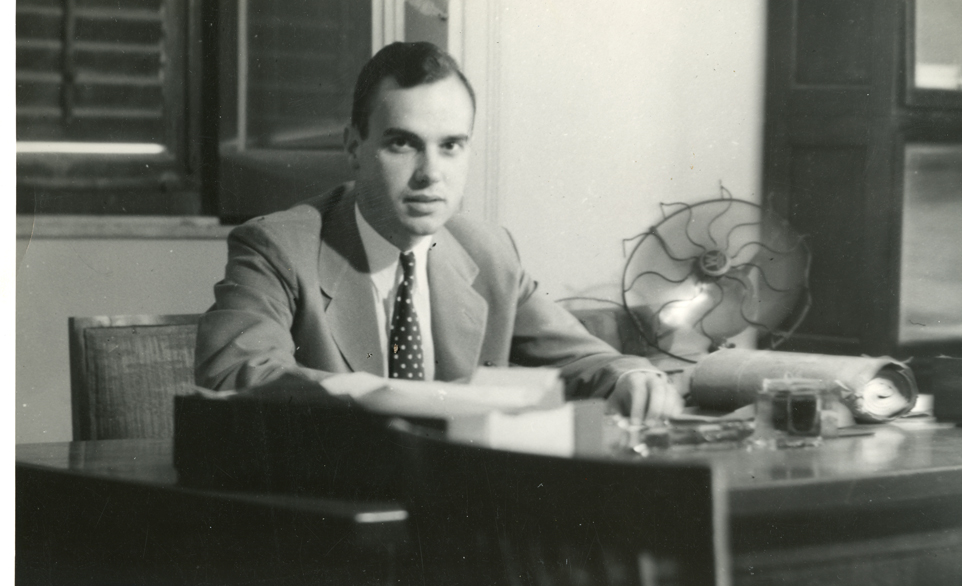
Bruce Forbes couldn’t believe his good luck. He had spent nearly 10 years as a Foreign Service officer with assignments from Palermo to Prague, but when he was appointed vice consul at the American embassy in Paris he felt as though he had won the lottery. For a man who enjoyed travel, spoke several languages, and loved public service, he couldn’t think of a better job.
On a sunny, late spring morning in 1953, his luck ran out.
Months earlier, President Eisenhower had issued an executive order that directed the firing of any government worker found to be gay or lesbian. Hundreds of agents were assigned the task of delving into the private lives of federal employees. Unbeknownst to Forbes, State Department investigators had been looking into his living arrangements. And they didn’t like what they found.
“I arrived for work and there they were,” Forbes recalls. “Three inquisitors. They got right to the point: ‘We understand you are living with a known homosexual.’”
It was true. Forbes was sharing a large apartment overlooking the Seine with an internationally known jewelry designer he had met years earlier in Palermo.
“But I’m not having an affair with him,” Forbes told his questioners. “For that matter, I’m not having an affair with anybody.”
That was true, too. But it didn’t much matter. In 1953, simply associating with a known homosexual was enough to get you fired. And not just from a federal job. The Eisenhower order required private companies doing business with the government to remove homosexuals from their payrolls as well. And, at the behest of Washington, the United Nations and U.S. NATO allies carried out similar purges.
The rationale behind the ban was that “perverts”—the word The New York Times freely used as a synonym for homosexuals—were a threat to national security because their secretive lifestyle left them susceptible to blackmail by foreign agents, who could supposedly induce them to reveal sensitive government information in exchange for avoiding exposure.
Despite the fact that not a single case of homosexual blackmail was ever discovered, the Eisenhower executive order had remarkable staying power. It wasn’t fully and officially revoked until President Clinton did so in 1995. Over a period of four decades, many thousands of gay men and lesbians lost their jobs. And it is impossible to say how many others were turned down for employment because they were suspected of being gay. By any measure it was the longest-lasting and most widespread witch hunt in American history.
Sixty years after this witch hunt—the “Lavender Scare”—began, the U.S. Senate voted to outlaw workplace discrimination based on sexual orientation and gender identity. Whether or not the bill senators passed last week makes it through the House, it’s more evidence of how far the government and the public have come on gay rights. But it’s also a reminder of a period of American history that’s been almost entirely forgotten.
Why doesn’t anyone know about a 40-year purge of thousands of innocent U.S. government employees and contractors? Because it was in everybody’s interest—the victims and the government alike—to keep the witch hunt a secret. Few who lost their jobs wanted to tell family or friends why they had left the government. Most were deeply in the closet and wanted—and needed—to stay there, particularly if they hoped to get other work. When confronted with evidence of their homosexuality, most resigned on the spot in exchange for a promise that their reasons for quitting would not be revealed. Those who balked were warned that they would be subject to further investigation; agents would visit their families and friends, who would find out about their sexual orientation.
“I submitted my resignation immediately,” says Bruce Forbes. “They didn’t have any evidence that I was gay, but if they had continued to investigate, they would have found it.”
Government officials had their own reasons for keeping quiet. They worried that if people found out just how many homosexuals were being fired, they’d demand to know why the government was sloppy enough to have hired so many of them in the first place. The result was a conspiracy of silence that benefited both sides.
In the mid-1990s, historian David K. Johnson got access to thousands of pages of newly declassified government documents that told this story in vivid detail. His 2006 book, The Lavender Scare, was the first to reveal the extent to which gay men and lesbians were victimized.
“These documents showed that this was no ad hoc campaign to get rid of a few troublesome gay people,” Johnson says. “I found page after page with the names of hundreds of people who lost their jobs. Transcripts of interrogations. Manuals instructing security officers on the best techniques to pressure people into confessing. Notes describing conversations with informants. It was chilling.”
Armed with this information, Johnson tracked down and interviewed dozens of individuals who experienced the Lavender Scare firsthand—victims of the scare and government officials alike. Thankfully many were still alive to talk about it.
As for Bruce Forbes, he quickly found another job—a better one, in fact. It would be decades before he revealed the real reason he quit the Foreign Service. His story, like those of other victims of the Lavender Scare, documents an important part of our past that nearly became lost forever.




Send A Letter To the Editors